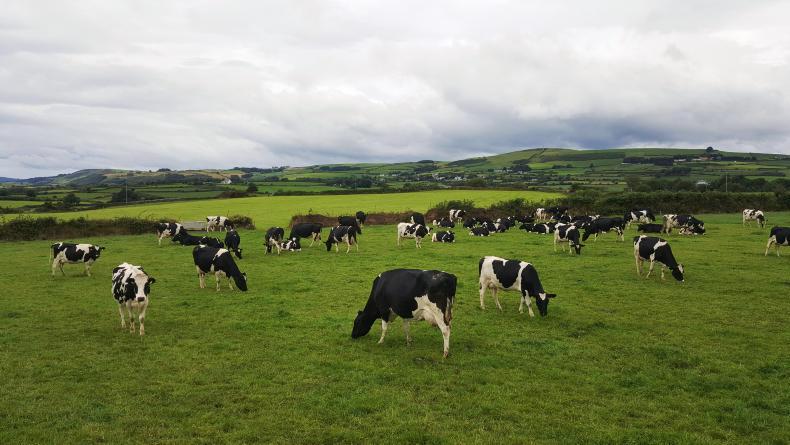The O’Sullivans previously won the Carbery milk supplier of the year award in 2005.
Winners are unable to compete for the following 10 years, so to win on their first year back in contention showed the standard and attention to detail put into producing high-quality milk.
In 2016, the O’Sullivans’ high milk composition gave a total of €10,431 (€149/cow) – more than the co-op average milk price.
Achieving the full SCC bonus was worth €2,138 (€31/cow).
A combination of low cell counts and high milk solids was worth an extra €12,569 (€180/cow) over the average Lisavaird supplier.

Nutrient management
They don’t blanket-spread fertiliser, instead they work out what each paddock needs in terms of fertiliser and spread accordingly.
The results of soil sampling are used to create a nutrient management plan, so the O’Sullivans know what to spread and where.
A printout of the plan is hanging in the dairy.
The whole farm gets a bag of urea/acre in spring, followed by a coating of 1,500 gallons of slurry/acre after the first grazing.
Paddocks that are low in P and K get 2,000 gallons. Some 40% of the farm is closed for first-cut silage, with no specific second cut. If grass covers go over 1,400kg DM/ha and the wedge allows, these paddocks are taken out for silage.
Slurry and soiled water are used after silage and along. They find soiled water of great benefit in dry weather, or on reseeded ground.
With 12t DM/ha grown in 2016, their cows had 306 days at grass.

Andrew O'Sullivan
The O’Sullivans have been incorporating high levels of clover over the last 15 years and are well used to managing it.
Despite the high clover content, bloat has never been an issue, with John Joe O’Sullivan saying the key was to have 12-hour allocations and make sure cows don’t go into high clover covers hungry.
Clover is included in all reseeds and they also oversow it.

Their clover oversowing technique:
Cut for silage.Seed spread with quad spreader.Pelleted seed used at 2kg/acre.Watery slurry applied at 2,000 gallons/acre.Grazed after three or four weeks.18-6-12 applied after grazing.Dirty water applied for remainder of year (no further bag fertiliser used). Farm figures.
The farm consists of 43.5ha (107acres) in total, with all the land in one block.
The herd is a closed herd, with no animals brought in. As a result, no vaccines are used – creating a cost saving.
A compact spring-calving herd, with 70 cows milked in 2016, producing 478kg of milk solids each, with 600kg of meal fed per cow.

The calving interval is 367 days, with 84% calved in six weeks and current 21-day submission rate is 99%. Average milk composition for last year was 4.35% butterfat and 3.79% protein.
The current EBI is €100 for cows, €119 for replacement heifers and €165 for calves. The stocking rate on the whole farm was 2.24 LU/ha.
Total costs, including labour, was 27.65/c, with variables cost of 9.50.c/l, with an average milk price of 32.89c/l.
Read more
Growing a business on leased land
US milk production on the rise
In pictures: breeding for the future at LIC farm walk
The O’Sullivans previously won the Carbery milk supplier of the year award in 2005.
Winners are unable to compete for the following 10 years, so to win on their first year back in contention showed the standard and attention to detail put into producing high-quality milk.
In 2016, the O’Sullivans’ high milk composition gave a total of €10,431 (€149/cow) – more than the co-op average milk price.
Achieving the full SCC bonus was worth €2,138 (€31/cow).
A combination of low cell counts and high milk solids was worth an extra €12,569 (€180/cow) over the average Lisavaird supplier.

Nutrient management
They don’t blanket-spread fertiliser, instead they work out what each paddock needs in terms of fertiliser and spread accordingly.
The results of soil sampling are used to create a nutrient management plan, so the O’Sullivans know what to spread and where.
A printout of the plan is hanging in the dairy.
The whole farm gets a bag of urea/acre in spring, followed by a coating of 1,500 gallons of slurry/acre after the first grazing.
Paddocks that are low in P and K get 2,000 gallons. Some 40% of the farm is closed for first-cut silage, with no specific second cut. If grass covers go over 1,400kg DM/ha and the wedge allows, these paddocks are taken out for silage.
Slurry and soiled water are used after silage and along. They find soiled water of great benefit in dry weather, or on reseeded ground.
With 12t DM/ha grown in 2016, their cows had 306 days at grass.

Andrew O'Sullivan
The O’Sullivans have been incorporating high levels of clover over the last 15 years and are well used to managing it.
Despite the high clover content, bloat has never been an issue, with John Joe O’Sullivan saying the key was to have 12-hour allocations and make sure cows don’t go into high clover covers hungry.
Clover is included in all reseeds and they also oversow it.

Their clover oversowing technique:
Cut for silage.Seed spread with quad spreader.Pelleted seed used at 2kg/acre.Watery slurry applied at 2,000 gallons/acre.Grazed after three or four weeks.18-6-12 applied after grazing.Dirty water applied for remainder of year (no further bag fertiliser used). Farm figures.
The farm consists of 43.5ha (107acres) in total, with all the land in one block.
The herd is a closed herd, with no animals brought in. As a result, no vaccines are used – creating a cost saving.
A compact spring-calving herd, with 70 cows milked in 2016, producing 478kg of milk solids each, with 600kg of meal fed per cow.

The calving interval is 367 days, with 84% calved in six weeks and current 21-day submission rate is 99%. Average milk composition for last year was 4.35% butterfat and 3.79% protein.
The current EBI is €100 for cows, €119 for replacement heifers and €165 for calves. The stocking rate on the whole farm was 2.24 LU/ha.
Total costs, including labour, was 27.65/c, with variables cost of 9.50.c/l, with an average milk price of 32.89c/l.
Read more
Growing a business on leased land
US milk production on the rise
In pictures: breeding for the future at LIC farm walk










 This is a subscriber-only article
This is a subscriber-only article











SHARING OPTIONS: